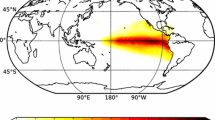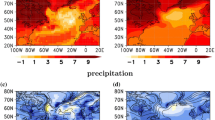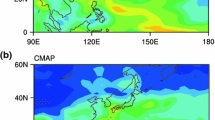Abstract
This study uses experiments with an atmospheric general circulation model (AGCM) to address the role of the oceans and the effect of land–atmosphere coupling on the predictability of summertime rainfall over northern Argentina focusing on interdecadal time scales during 1901–2006. Ensembles of experiments where the AGCM is forced with historical sea surface temperature (SST) in the global, Pacific and tropical-North Atlantic domains are used. The role of land–atmosphere interaction is assessed comparing the output of simulations with active and climatological soil moisture. A maximum covariance analysis between precipitation and SST reveals the impact of the Pacific Decadal Oscillation, the Atlantic Multidecadal Oscillation and the equatorial–tropical South Atlantic on rainfall over northern Argentina. Model simulations further show that while the dominant influence comes from the Pacific basin, the Atlantic influence can explain a large transition from dry to wet decades over northern Argentina during the beginning of the 1970s. Analysis of anomalies before and after the transition reveals an upper level anticyclonic circulation off the Patagonian coast with barotropic structure. This circulation enhances the moisture transport and convergence in northern Argentina and, together with enhanced evaporation, increased the rainfall after 1970. The SST pattern is dominated by cold conditions in the equatorial Atlantic and warm eastern Pacific and South Atlantic. We also found that land–atmosphere interaction leads to a representation of the long term rainfall evolution over northern Argentina that is closer to the observed one. Moreover, it leads to a smaller dispersion among ensemble members, thus resulting in a larger signal-to-noise ratio.



















Similar content being viewed by others
References
Andreoli RV, Kayano MT (2005) ENSO related rainfall anomalies in South America and associated circulation features during warm and cold Pacific decadal oscillation regimes. Int J Climatol 25:2017–2030
Antico PL (2008) Relationships between autumn precipitation anomalies in southeastern South America and El Niño events classification. Int J Climatol 29:719–727. doi:10.1002/joc.1734
Baldi G, Paruelo JM (2008) Land-use and land cover dynamics in South American temperate grasslands. Ecol Soc 13(2):6
Barreiro M (2010) Influence of ENSO and the South Atlantic Ocean on climate predictability over Southeastern South America. Clim Dyn 35:1493–1508. doi:10.1007/s00382-009-0666-9
Barreiro M, Diaz N (2011) Land–atmosphere coupling in El Niño influence over South America. Atmos Sci Lett 12:351–355. doi:10.1002/asl.348
Barreiro M, Tippmann A (2008) Atlantic modulation of El Niño influence on summertime rainfall over Southeastern South America. Geophys Res Lett 35. doi:10.1029/2008GL035019
Barreiro M, Giannini A, Chang P, Saravanan R (2004) On the role of the South Atlantic atmospheric circulation in tropical Atlantic variability. In: Wang C, Xie SP, Carton JA (eds) Earth’s climate: the ocean–atmosphere interaction. Geophysical Monograph Series 147, AGU, Washington, pp 143–156
Boulanger J-P, Leloup J, Penalba O, Rusticucci M, Lafon F, Vargas W (2005) Observed precipitation in the Paraná-Plata hydrological basin: long-term trends, extreme conditions and ENSO teleconnections. Clim Dyn 24:393–413. doi:10.1007/s00382-004-0514-x
Castañeda E, Barros V (2001) Tendencias de la precipitación en el oeste de Argentina. Meteorologica 26:5–23
Cazes-Boezio G, Robertson AW, Mechoso CR (2003) Seasonal dependence of ENSO teleconnections over South America and relationships with precipitation in Uruguay. J Clim 16:1159–1176
Chan SC, Behera SK, Yamagata T (2008) Indian Ocean dipole influence on South American rainfall. Geophys Res Lett. doi:10.1029/2008GL034204
Collini EA, Berbery EH, Barros VR, Pyle ME (2008) How does soil moisture influence the early stages of the South American monsoon? J Clim 21:195–213
Compo GP, Whitaker JS, Sardeshmukh PD, Matsui N, Allan RJ, Yin X, Gleason BE, Vose RS, Rutledge G, Bessemoulin P, Brönnimann S, Brunet M, Crouthamel RI, Grant AN, Groisman PY, Jones PD, Kruk M, Kruger AC, Marshall GJ, Maugeri M, Mok HY, Nordli O, Ross TF, Trigo RM, Wang XL, Woodruff SD, Worley SJ (2011) The twentieth century reanalysis project. Q J R Meteorol Soc 137:1–28
Ding Q, Steig EJ, Battisti DS, Wallace JM (2012) Influence of the tropics on the southern annular mode. J Clim 25:6330–6348
Fuchs T, Schneider U (2009) GPCC annual report for year 2008. http://gpcc.dwd.de/
Garreaud R, Lopez P, Minvielle M, Rojas M (2013) Large scale control on the Patagonia climate. J Clim 26:215–230
Gonzalez P, Polvani LM, Seager R, Correa GP (2013) Stratospheric ozone depletion: a key driver of recent precipitation trends in South Eastern South America. Clim Dyn. doi:10.1007/s00382-013-1777-x
Grimm AM, Ambrizzi T (2009) Teleconnections into South America from the tropics and extratropics on interannual and intraseasonal time scales. In: Vimeux F et al (eds) Past climate variability in South America and surrounding regions: from the last glacial maximum to the Holocene, developments in paleoenvironmental research and risk assessment, pp 159–191. doi:10.1007/978-90-481-2672-9
Grimm AM, Barros VR, Doyle M (2000) Climate variability in southern South America associated with El Niño and La Niña events. J Clim 13:35–58
Grimm AM, Pal JS, Giorgi F (2007) Connection between spring conditions and peak summer monsoon rainfall in South America: role of soil moisture, surface temperature, and topography in eastern Brazil. J Clim 20:5929–5945. doi:10.1175/2007JCLI1684.1
Harris I, Jones PD, Osborn TJ, Lister DH (2012) Updated high-resolution grids of monthly climatic observations—the CRU TS3.10 dataset. Int J Climatol. doi:10.1002/joc.3711
Kalnay E, Kanamitsu M, Kistler R, Collins W, Deaven D, Gandin L, Iredell M, Saha S, White G, Woollen J, Zhu Y, Leetmaa A, Reynolds B, Chelliah M, Ebisuzaki W, Higgins W, Janowiak J, Mo KC, Ropelewski C, Wang J, Jenne R, Joseph D (1996) The NCEP/NCAR 40-year reanalysis project. Bull Am Meteorol Soc 77:437–471
Kayano MT, Andreoli RV (2007) Relation of South American summer rainfall interannual variations with the Pacific decadal oscillation. Int J Climatol 27:531–540
Koster RD, Suarez MJ, Heiser M (2000) Variance and predictability of precipitation at seasonal-to-interannual timescales. J Hydrometeorol 1:26–46
Koster RD et al (2004) Regions of strong coupling between soil moisture and precipitation. Science 305:1138–1140
Kucharski F, Molteni F, Bracco A (2005) Decadal interactions between the western tropical Pacific and the North Atlantic Oscillation. Clim Dyn. doi:10.1007/s00382-005-0085-5
Kucharski F, Bracco A, Yoo JH, Tompkins AM, Feudale L, Ruti P, Dell’Aquila A (2009) A Gill–Matsuno type mechanism explains the tropical Atlantic influence on African and Indian monsoon rainfall. Q J R Meteorol Soc. doi:10.1002/qj.406
Limpasuvan V, Hartmann DL (1999) Eddies and the annular modes of climate variability. Geophys Res Lett 26:3133–3136
Ma H-Y, Mechoso CR, Xue Y, Xiao H, Wu C-M, Li J-L, De Sales F (2010) Impact of land surface processes on the South American season climate. Clim Dyn. doi:10.1007/s00382-010-0813-3
Magrin GO, Travasso MI, Rodriguez GR (2005) Changes in climate and crop production during the 20th century in Argentina. Clim Change 72:229–249
Mantua NJ, Hare SR, Zhang Y, Wallace JM, Francis RC (1997) A Pacific interdecadal climate oscillation with impacts on salmon production. Bull Am Meteorol Soc 78(6):1069–1079
Misra V (2008) Coupled air, sea and land interactions of the South American Monsoon. J Clim 21:6389–6403
Mo KC, Berbery EH (2011) Drought and persistent wet spells over South America based on observations and the U. S. CLIVAR drought experiments. J Clim 24:1801–1820
Piovano E, Ariztegui D, Bernasconi S, McKenzie J (2004) Stable isotopic record of hydrological changes in subtropical Laguna Mar Chiquita (Argentina) over the last 230 years. The Holocene 14:525–535
Pisciottano G, Díaz A, Cazes G, Mechoso CR (1994) El Niño-Southern Oscillation impact on rainfall in Uruguay. J Clim 7:1286–1302
Renom M, Rusticucci M, Barreiro M (2011) Multidecadal changes in the relationship between extreme temperature events in Uruguay and the general atmospheric circulation. Clim Dyn 37:2471–2480. doi:10.1007/s00382-010-0986-9
Schneider U, Fuchs T, Meyer-Christoffer A, Rudolf B (2008) Global precipitation analysis products of the GPCC. Global Precipitation Climatology Centre Tech Rep, 12 pp
Seager R, Harnick N, Kushnir Y, Robinson W, Miller J (2003) Mechanisms of hemispherically symmetric climate variability. J Clim 13:1000–1016
Seager R, Naik N, Baethgen W, Robertson A, Kushnir Y, Nakamura J, Jurburg S (2010) Tropical oceanic causes of interannual to multidecadal precipitation variability in southeast South America over the past century. J Clim 23:5517–5539
Silvestri G (2004) El Niño signal variability in the precipitation over southeastern South America during austral summer. Geophys Res Lett. doi:10.1029/2004GL020590
Smith TM, Reynolds RW (2004) Improved extended reconstruction of SST (1854–1997). J Clim 17:2466–2477
Sorensson AA, Menéndez CG (2010) Summer soil–precipitation coupling in South America. Tellus Ser A 63:56–68
Sterl A (2004) On the in-homogeneity of reanalysis products. J Clim 17:3866–3873
Taschetto AS, Ambrizzi T (2012) Can Indian Ocean SST anomalies influence South American rainfall? Clim Dyn 38:1615–1628
Thompson DWJ, Wallace JM (2000) Annular modes in the extratropical circulation. Part I: Month-to-month variability. J Clim 13:1000–1016
Troin M, Vallet-Coulomb C, Sylvestre F, Piovano E (2010) Hydrological modeling of a closed lake (Laguna Mar Chiquita, Argentina) in the context of 20th century climatic changes. J Hydrol 393. doi:10.1016/j.jhydrol.2010.08.019
Uppala SM et al (2005) The ERA-40 reanalysis. Q J R Meteorol Soc 131(612):2961–3012
Xue Y, De Sales F, Li W, Mechoso CR, Nobre C, Juang H-MH (2006) Role of land surface processes in South American monsoon development. J Clim 19:741–762
Yu B, Lin H (2013) Tropical American-Atlantic forcing of austral summertime variability in the southern annular mode. Geophys Res Lett 40:943–947. doi:10.1002/GRL.50231
Zeng N, Neelin JD, Chou C (2000) A quasi-equilibrium tropical circulation model—implementation and simulation. J Atmos Sci 57:1767–1796
Zhou J, Lau K-M (2001) Principal modes of interannual and decadal variability of summer rainfall over South America. Int J Climatol 21:1623–1644
Acknowledgments
The research leading to these results has received funding from the European Community’s Seventh Framework Programme (FP7/2007–2013) under Grant Agreement No. 212492 (CLARIS LPB a Europe-South America Network for Climate Change Assessment and Impact Studies in La Plata Basin) and from CSIC-Universidad de la República. We are also grateful to three reviewers for their valuable suggestions that greatly improved the manuscript.
Author information
Authors and Affiliations
Corresponding author
Rights and permissions
About this article
Cite this article
Barreiro, M., Díaz, N. & Renom, M. Role of the global oceans and land–atmosphere interaction on summertime interdecadal variability over northern Argentina. Clim Dyn 42, 1733–1753 (2014). https://doi.org/10.1007/s00382-014-2088-6
Received:
Accepted:
Published:
Issue Date:
DOI: https://doi.org/10.1007/s00382-014-2088-6




